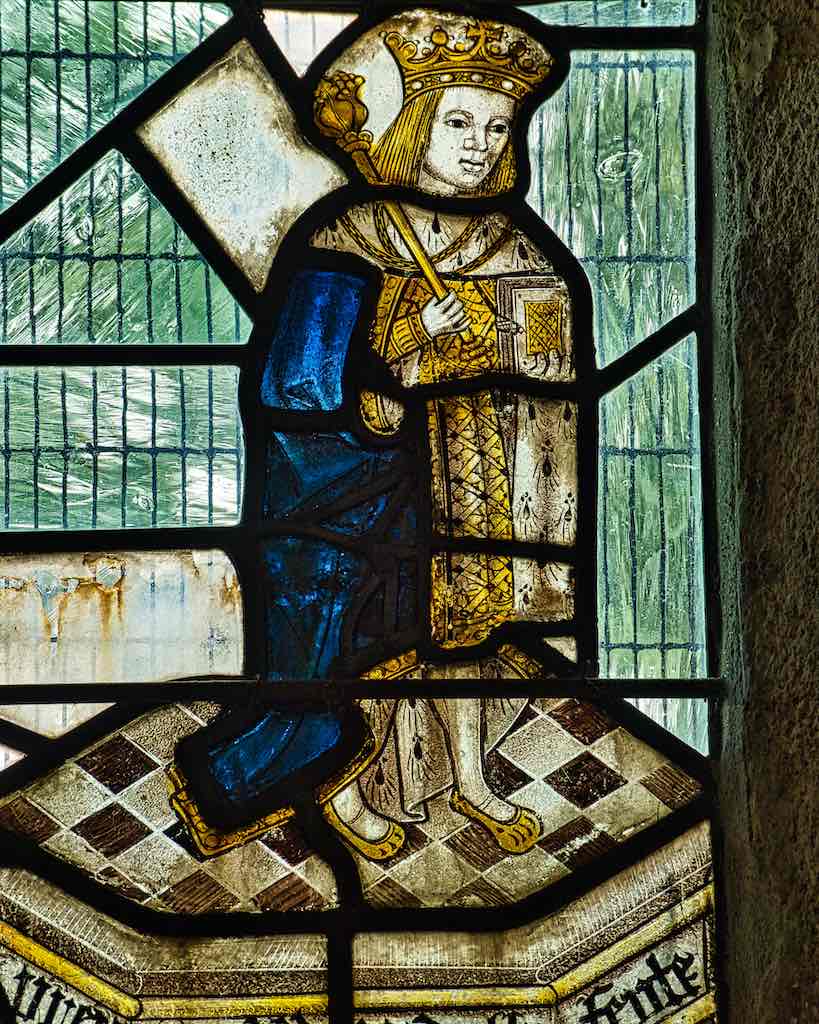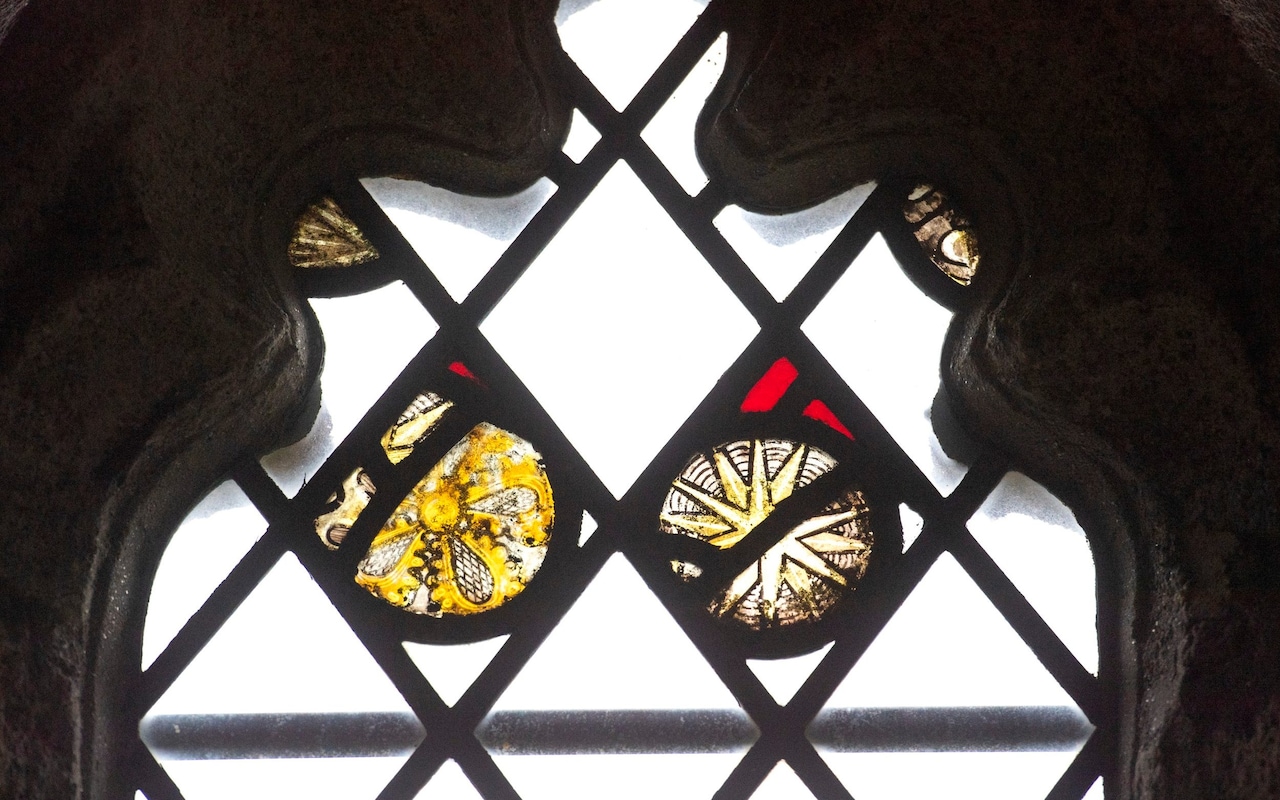
Stained glass image of Edward V Coldridge Church, Devon,
This wonderful church in Devon contains some little gems including a charming portrait of the young Edward V in a stained glass window, king for such a short while.
The story of Edward and his brother, Richard of Shrewsbury is well known, their disappearance still a matter of great debate and well documented elsewhere so I won’t go into it here. Over the years his ‘murder’ has, in general, been attributed to his uncle Richard III but now more enlightened historians plus a great band of Ricardian followers have taken up the cudgel on his behalf and are now disputing that version of events and seeking to find the truth. Whatever that truth is, and personally I think they were separated and then taken to places of safety, it is hard not to feel sympathy towards the young boy who for eleven weeks was king only to be informed this was not actually the case. For all his short life up until then he had been shielded from the harsh realities of life and utterly indulged as heirs to the throne are. Even while still a tiny child his wardrobe was extravagant. A surviving account records clothing being delivered for his use not later than November 1472: five doublets priced 6s 8d, two of velvet – purple or black – and three of satin, two being green or black, five long gowns price 6s 8d, three being satin – purple, black and green and the others of black velvet; two bonnets, price 2s, one of purple velvet lined with green satin and the other of black velvet lined with black satin; and a sixth, even more splendid long gown cloth of gold on damask priced £1 (1) . When they broke the news to him and reality kicked in – there was to be no coronation, no crown and a complete and utter loss of status – it must have come as a massive, massive shock and through no fault of his own. Poor little blighter. That fault and blame must land fair and square on his parents shoulders, particularly his father. Yes the buck stops with Edward IV who kept his brains in his pants and a lot of people paid a heavy price for that…tsk. Historian Michael Hicks in his biography of Edward V say as much: ‘The blame rests firmly with Edward V’s father whose dishonourable conduct, faithlessness and duplicity as much as his sexual immorality was two decades later to place in doubt the title of a son who had not then even been born’ (2 ).
Not surprisingly because of the window, which is in the Evans chapel, and a tomb with a beer stone effigy of John Evans upon it, the intriguing theory has grown that this church could be the final resting place of the disappeared Edward V – John Evans being Edward incognito. Clues abound including the Sunne in Splendour, a Yorkist emblem, in a window and Yorkist Roses carved on wooden bosses.

A Sunne in Splendour, a Yorkist symbol, in one of the windows in the church. Photo John Dike.

The large crown at one time would have been in a different window. Believed to have originally been on top of a royal standard? Note the deer in the ermine. Was this a nod to John Evans’- alias Edward V – occupation as a Parker of the deer park at Coldridge i.e.
John who died c.1511, was said to have came from Wales – thus the name Evans which is Welsh – EVans – Edward V – one time Prince of Wales – get it? – please keep up at the back dear reader. It should also be remembered that Ludlow, where Edward spent most of his life up until 1483 was in the Welsh Marches and not Shropshire as it is today. The effigy is wearing chainmail under his robe and the story goes that John turned up in Coldridge in 1485 after the battle of Bosworth. IF he had been Edward he would have been around 15 at that time. There is however reason to believe that he had arrived earlier in 1484. His mother Elizabeth Wydeville had emerged from sanctuary at Westminster accompanied by her daughters on the 1st March of that year. She had reached an agreement with Richard III and wrote to her son Thomas Grey, Marquess of Dorset, who had owned Coldridge prior to it being confiscated by Richard, but was now in France with Henry Tudor, telling him to return home as Richard would pardon him. Two days later on the 3 March a trusted follower of the king, Robert Markenfield was sent from Yorkshire to Coldridge. Was this to keep an eye on the young lad who had been king for such a short time, Edward V, and who had been secreted away at the former property of his half brother, Dorset, a property which was about to returned to him if it had not already been done so?
Robert Markyngfeld/the keping of the park of Holrig in Devonshire during the kinges pleasure… Harleian Manuscript 433. Vol.1.
The following year Richard was to die at Bosworth. Dorset would finally return to England and his estates were once again in his control. Did this enable Edward V to continue to live out his life in Coldridge in obscurity living as John Evans, keeper of the deer park?
Later in 1487 Elizabeth Wydeville would be sent to live out the rest of her life in Bermondsey Abbey after a council meeting had been called to discuss the Lambert Simnel rebellion. Dorset would be sent to the Tower for a short while until the rebellion was put down. Surely there is no stronger indication than this that Elizabeth believed that at least one of her sons still lived – and was this son Edward V now living incognito at Coldridge?
Turning back to the windows it is indeed strange and as the author of an article on the Devonchurchland website (and what a beauty of a website!) points out why would a small church ‘in a gritty little village lost in the boondocks of Devon’ have such a wonderful royal and extremely rare window?
There is also a medieval stained glass portrait of a man who appears to be holding an open crown very similar to the one hovering over Edward’s head – you can clearly see the fleur-de-lis at the bottom of the portrait. If you look closely you can also spot an ermine collar, ermine would of course only been worn by the nobility. How strange. Is this a portrait of John Evans, who if he was indeed Edward, would have been around 41 when he died.

Medieval portrait of a man. He appears to be looking down at an open crown which is almost identical to the one in the image of Edward V. Is this man the mature John Evans/Edward V? Compare to the image of the young Edward.

The early 16th century stained glass portrait of Edward V. Confirmed by expert Beatrix Cresswell to be genuine.

John Evans, his effigy in the Evans Chapel, gazing at the window depicting the young Edward V. The effigy has an angel at his head carrying a shield inscribed with his name ‘John Evas’ (sic).
Apparently according to the article, and thank goodness for it, there are ‘folk looking into it, one of them the lady who discovered Dick’s body in that car park’. So lets hope the indefatigable Philippa Langley does indeed get to the bottom of this mystery and no doubt the late Dr John Ashdown Hill will be cheering her on. Meanwhile John Evans’ effigy gazes in perpetuity, at the portrait in the window said to be that of himself, to this day.
However back to the church. These are just a few of the many delightful photos I have taken from Devon Churchland, after being alerted to this amazing website by a post on the Medieval Buildings Facebook page – thank you, thank you thank you!

Coldridge Church of St Matthew under a glowering Devon sky.

Ancient priests door

Carving in the Rood screen

Another view of the Rood Screen

Medieval pulpit. Once possibly gilded. Can you imagine?

Detail of the Pulpit carving..

Close up of the fine carving…just no words!

Wooden ceiling of the church

Screen carved by Breton craftsmen – rare.


Medieval benchends..

Examples of the numerous wooden roof bosses. Note what could be the White Rose of York.

The alter with east window above

The lectern.



Could these portraits and the effigy be one of the same person – Edward V?
So is the portrait in the window really that of Edward V and was John Evans actually Edward reinvented? You will have to make your own minds up dear readers. Hopefully one day further research into John Evans will prove or disprove this intriguing story once and for all.
In the meantime its tempting to speculate which leads to further questions :
If John Evans was indeed Edward what where his thoughts on the young man known as Perkin Warbeck who claimed to be Edward’s younger brother Richard? Would Warbeck’s brutal fate in 1499 have strengthened his resolve to remain incognito especially if he liked his head where it was – on top of his shoulders? And finally did Elizabeth Wydville who died in 1492 in Bermondsey Abbey go to her grave with the knowledge that at least one of her sons was safe and living in rural Devon on his half-brother’s property?
‘(1) Edward V, The Prince in the Tower, p.63. Michael Hicks.
(2) Ibid p.48
If you have enjoyed this post you might like Edward of Middleham ‘Son to Kyng Richard and the Mysterious Sheriff Hutton Monument’
James Tyrell Child Killer or Provider of a Safe House
MARKENFIELD HALL & THE MARKENFIELD BROTHERS, THOMAS AND ROBERT
A PORTRAIT OF EDWARD V AND THE MYSTERY OF COLDRIDGE CHURCH…Part II A Guest Post by John Dike.
Are john evans’ bones in the church,/church eard ? They mght yield some identifying DNA
LikeLike
At the moment the remains of John Evans have not been found.
LikeLike